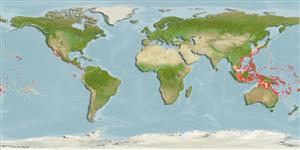Common names from other countries
Issue
Distribution of this species is considered to be in the Indian Ocean and the Red Sea by Randall et al., 2014 (Ref. 95583), while Pacific Ocean by Koeda et al., 2014 (Ref. 95675).
Environment: milieu / climate zone / depth range / distribution range
Ecología
marino asociado a arrecife; rango de profundidad 5 - 40 m (Ref. 9710). Tropical
Distribución
Países | Áreas FAO | Ecosistemas | Ocurrencias, apariciones | Point map | Introducciones | Faunafri
Pacific Ocean. Allopatric with sister species Pempheris tominagai which is widely distributed in the Indian Ocean and the Red Sea.
Tamaño / Peso / Age
Maturity: Lm ? range ? - ? cm
Max length : 15.0 cm TL macho / no sexado; (Ref. 2334)
Espinas dorsales (total) : 6 - 7; Radios blandos dorsales (total) : 9 - 10; Espinas anales: 3; Radios blandos anales: 35 - 42; Vértebra: 25. This species is characterized by the following: 3.5 scale rows above lateral line; usually pinkish caudal fin in fresh specimens; posterior nostril usually compressed (Ref. 95675).
Inhabits rocky and coral reefs (Ref. 9710). Found hiding in caves during the day and feeding on zooplankton at night. Solitary or in small groups (Ref. 48636).
Life cycle and mating behavior
Maturities | Reproducción | Spawnings | Egg(s) | Fecundities | Larva
Randall, J.E., G.R. Allen and R.C. Steene, 1990. Fishes of the Great Barrier Reef and Coral Sea. University of Hawaii Press, Honolulu, Hawaii. 506 p. (Ref. 2334)
IUCN Red List Status (Ref. 130435)
CITES (Ref. 128078)
Not Evaluated
Threat to humans
Harmless
Human uses
Herramientas
Special reports
Download XML
Fuentes de Internet
Estimates based on models
Preferred temperature (Ref.
115969): 24.4 - 29, mean 27.9 (based on 490 cells).
Phylogenetic diversity index (Ref.
82804): PD
50 = 0.5000 [Uniqueness, from 0.5 = low to 2.0 = high].
Bayesian length-weight: a=0.01288 (0.00539 - 0.03078), b=3.03 (2.84 - 3.22), in cm Total Length, based on LWR estimates for this Genus-body shape (Ref.
93245).
Nivel trófico (Ref.
69278): 3.4 ±0.45 se; based on food items.
Resiliencia (Ref.
120179): Alto, población duplicada en un tiempo mínimo inferior a 15 meses (Preliminary K or Fecundity.).
Fishing Vulnerability (Ref.
59153): Low vulnerability (10 of 100).
